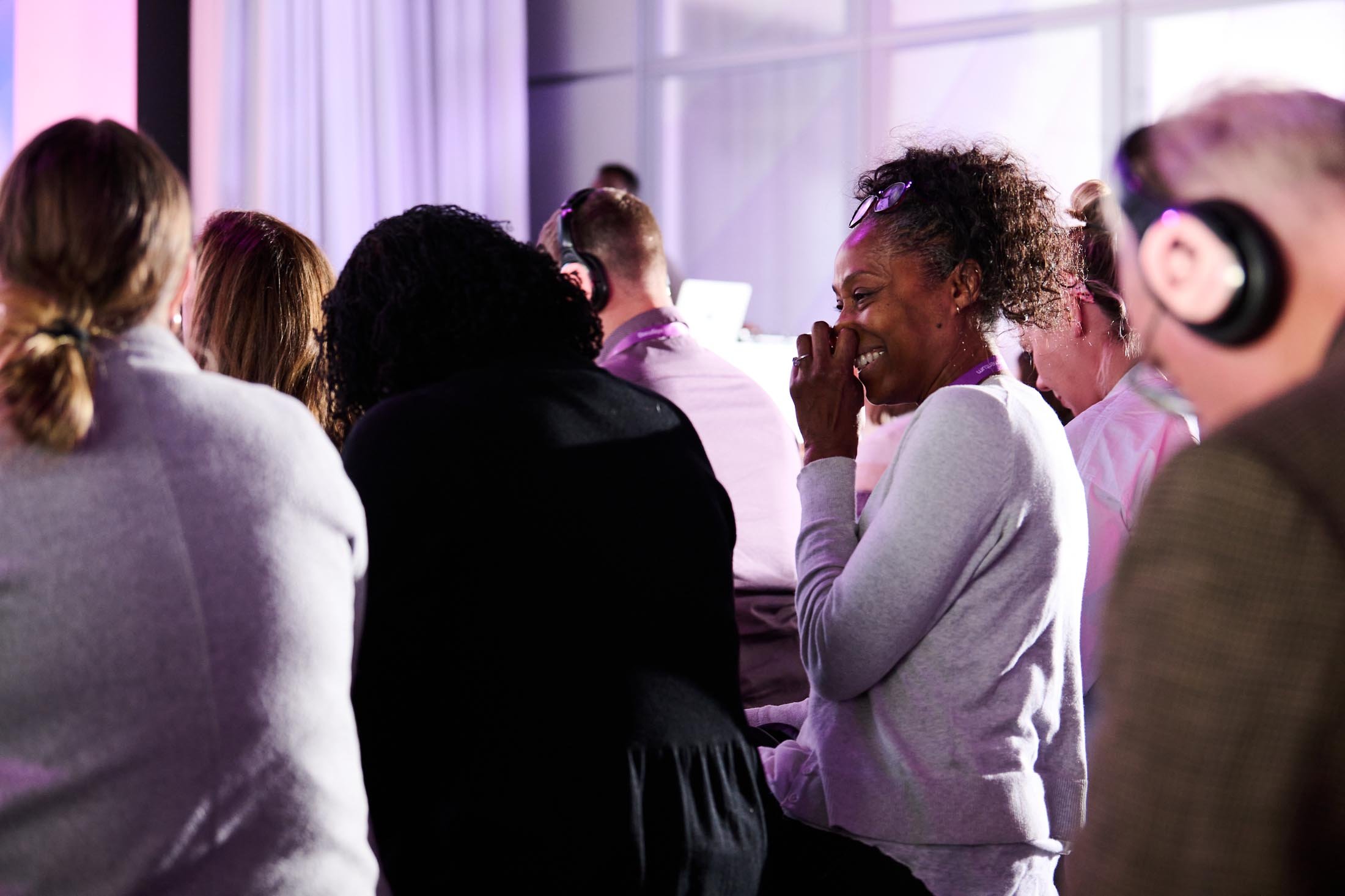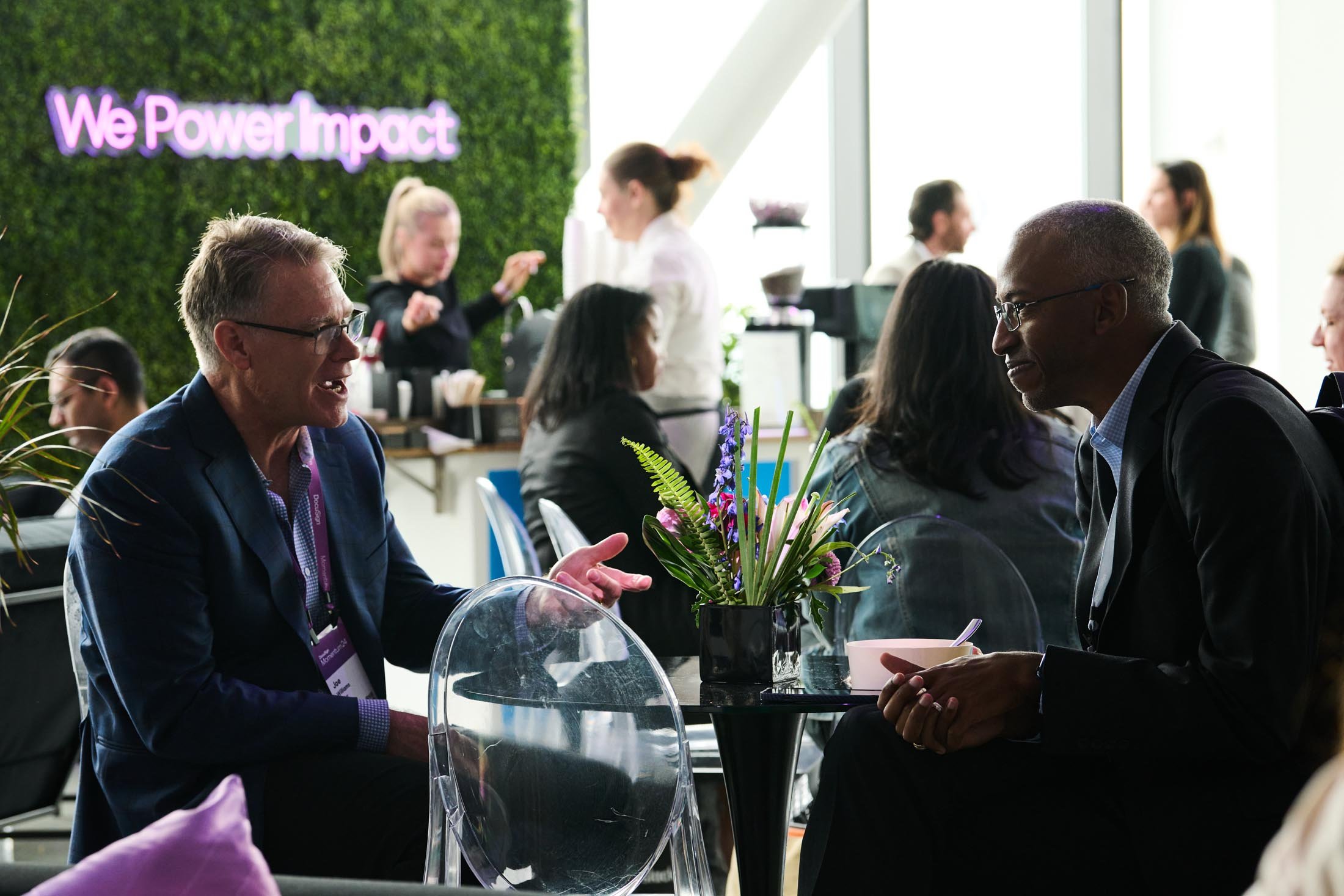5 Examples of Great Corporate Event Photography.
Marketing image taken at Docusign’s Momentum 2024. Taken with an on camera speed light and a Profoto B2 head / zoom reflector.
If you find yourself googling “What should I know as a corporate event photographer?” I can definitely help you out.
Corporate event photography is a fairly straightforward sub-discipline within the overall genre that is event photography.
Typically, businesses and corporations will hire photographers to capture everything from conferences, to keynotes, to fireside chats, to panels, and to client mixers (and much, much more).
And, while the reasons for hiring a corporate event photographer can be incredibly varied, that photographer is usually there for one purpose and one purpose only: marketing.
I’ve created this handy list that’s not only of benefit to you if you’re an event photographer, but also is of benefit if you’re a client.
Table of Contents
1. Event photograph with an External Light Source
Rim lighting at The Addis Tax Initiative meeting, over by the UN. Had it not been for this, the lighting would have been hum-drum overhead fluorescent and look nowhere near as impressive.
Lighting at a corporate event can be nothing short of a majestic affair. Stage lighting, bay windows flanking the venue, overhead skylights, and motorized spots designed to bedazzle the crowd all work in unison to unveil a new product and kick off an important keynote.
Most recently, I shot at The Glass House in New York City, capturing Docusign’s annual conference, Momentum ‘24. Reese Witherspoon joined CEO Allen Thygesen onstage to discuss the trajectory of the own insane success she experienced after forming her own production company and instantly creating hits like ‘Gone Girl.’
The images that I was able to create are nothing short of gorgeous and, while much of that had to do with a combination of my own and experience and the gear I was packing (I had a Z9, a 70-200, and a 14-24), the overwhelming majority of it came down to the venue I was shooting in. The Glass House is easily one of the most stunning venues in all of New York City, and it shows. The building itself is composed of massive bay windows overlooking the Hudson and a multimillion dollar soundstage. You can see from the photos attached that a large part of why the images I was able to create for Docusign were so amazing was because the venue itself was amazing.
Reese Witherspoon on stage with Allen Thygesen, The Glass House NYC for Momentum 2024
However, I’ve been to plenty of corporate event venues (especially at hotels) where the lighting is abysmal. In situations like this, not only is the lighting abysmal, but the stage lighting can be vastly inadequate and force you to shoot at some ungodly ISO, like 4000+, and wedge you into the creation of a bunch of poorly lit, grainy af images that no amount of explanation to the client will save you from.
Remember this, if you take one thing away from this article: You can be shooting in a post-war parking garage covered in rust, weeds, mildew, and gangrene, and the client will still blame you, no matter what, for the crappy images. If you’re shooting in a poorly lit venue, the client won’t accept that it’s poorly lit - only that you’re a poor photographer.
And, with this said, I’ve gotten into the habit of not only carrying a few speedlights around with me, but a couple strobes as well. I purchased the Profoto B2 kit some years ago and, when paired with a zoom reflector, works absolute wonders for stage lighting. It’s literally saved me more times than I can count. As well, if you place it on the opposite side of you, it provides an insanely pleasing rim light on the speaker that clients will lose their sh#t over.
2. Marketable images is all anyone ever wants out of this
This is an event photo but could be a campaign image, it’s so good. People smiling, good lighting, and the brand happily plugging away in the background. What’s better than this?
I once had a client hire me and his first question upon arrival at the venue was this:
“You aren’t going to send me a bunch of photos of like, water bottles and things are you?”
And I went ‘No? Why?’
And he responded, “well, the last photographer I hired ended up sending me a bunch of images of Aquafina water bottles with blurred backgrounds. I think he was trying to be artistic.”
30 photos of water bottles taken at various angles with a soft bokeh might look cool to a water bottle company. To all others, let’s focus on other things
I feel like much of professional photography and the people that inhabit it is a product of monkey-see-monkey-do. You ask people what their rates are and they pull some exorbitant number off the top of their head and if you ask them to explain that number their only reason is that it’s what their neighbor charges - god forbid that person come to that number off their experience or skill level.
The same can be said of event photography. Ask a guy why he’s sending a client artsy photos of pigs in a blanket from their company’s 50th anniversary party and he’ll likely respond that he once saw photos that were very similar in another photographer’s portfolio and just figured that’s what photographers do.!
Let’s be clear, here: The company you’re working for doesn’t really give a shit about how artistically you can render pigs in a blanket. It’s great that you can, and I guess it can be argued that cooked bologna wrapped up in cabbage plays an integral role to appropriately illustrating just how amazing a company’s 50th anniversary celebration was - but for the most part, those sorts of photos aren’t really going to be super critical to telling a story.
What is going to be critical to telling a story is, say, a toast. Or two people laughing hysterically at a shared joke. Or the event signage outside of a particularly interesting looking skyscraper.
All of those things will play a role in establishing a narrative of events that you’ll in turn use and your client, will in turn, love you for.
3. Setting up shots
I set this shot up and asked the woman to look happy and the simple act of asking her to do so made her, in fact, happy.
I’ve been living in New York City since 2008. When I arrived, which I find strange to say was well over a decade ago, I was a pretty timid person.
I hesitated to ask strangers for directions. I routinely went in the wrong direction on the subway and sat there silently stewing while convinced everyone on the train knew that I was an idiot.
Once, even, one of the most attractive girls asked if she could share a table with me at Starbucks. There we sat, myself and her and no one else, and I was so under spoken I couldn’t bring myself to even say hello.
Now, however, I clip shoulders while cannon-balling down the sidewalks of New York with the very best of them. I curse loudly at people I see littering in public. I sit shoulder to shoulder with people on the train and make no attempt to else up less mass if they aren’t doing the same.
This being said, I’ve gotten to be pretty good at being shameless while doing my event work and regularly set up ‘posed candids.’
You don’t have to be overbearing about it and start barking orders at people and saying things like ‘You! Stand over there and smile. Right now!’
This being said, if you see two people sitting together in a way / place that you think might make for a nice photo, but maybe they’re looking a little serious, walking over and saying something like ‘Excuse me, not to be a shameless douchebag, but if you were to like, say, smile while having this conversation, it’d make my life a million times easier.’
9/10 times people will be happy to oblige you, and oftentimes even asking them produces an authentic smile to begin with. People like helping one another, when they can, and it’s such an offbeat and unexpected question that since working this into my photography, I’ve never once had a refusal.
The client will completely love you for it, as well, because smiling candids are like, half of corporate event photography to begin with.
Two panel attendees chat in front of a window at the UN. Taken on a 50mm 1.4
4. Carrying two cameras around at all times is the norm
This being said, I carry two cameras around me at all times. I use a black rapid dual camera strap and, depending on the situation, will either have a 70-200 on one and a 24-70 on the other (this is usually my keynote configuration, though in the crowd is especially big and the venue especially large, I’ll often switch the 24-70 out with a 14-24.)
For smaller corporate functions, I’ll usually have a 24-70 on one cam and a 50 1.4 on the other. The reason for my 50 1.4 stationed on cam 2 is that I’ll shoot without a speedlight attached and use it for available light only. Even if the lighting in the venue is awful, there’ll usually be an opportunity to grab a handful of photos over by windows and near terraces.
Windows themselves produce super soft lighting and make for the most marketable and photogenic images you’ll likely take over the course of your event. If you’re in the corner of a building, or the room is small enough to the point where two windows with opposite sides of one another create ample light, getting a rim light behind the subject while at the same time having enough fill to evenly illuminate them will go a long way in producing marketable work.
5. Candids, Candids, Candids
What, exactly, is more marketable than this photo? Nothing is the answer.
Your corporate clients are going to have a shot list and on that shot list will be items like ‘keynote speech’ and ‘banners and signage’ and ‘stilt walker dressed up like a unicorn,’ and your job will be to get images of those three items. And you will. But, the vast majority of your imagery is going to revolve around candids and people having a good time interacting; or, looking super absorbed and engrossed with the stage presentations.
Think about it in a marketing material sense - what sort of imagery do you see on brochures and email blasts? Stilt walkers? Signage? Or people checking in at registration with a massive smile on their faces.
Focus on candids and specifically ones of people laughing and having a good time for the bulk of what content you create, and you really can’t go wrong.





